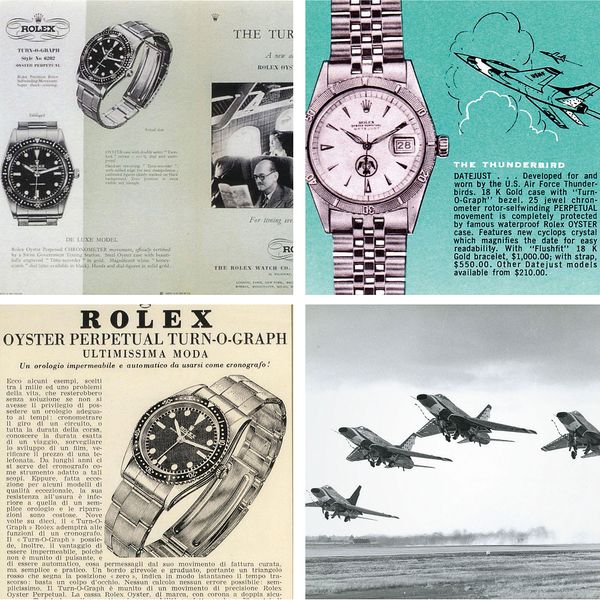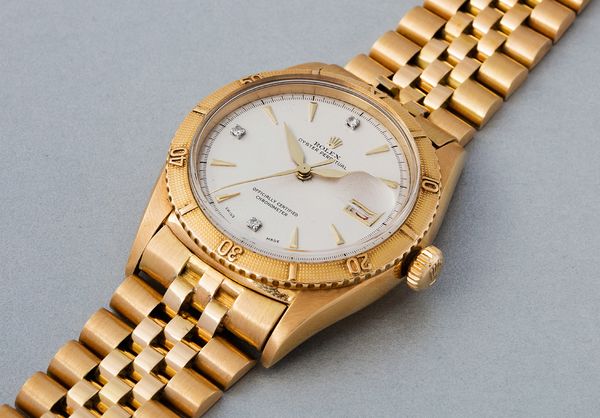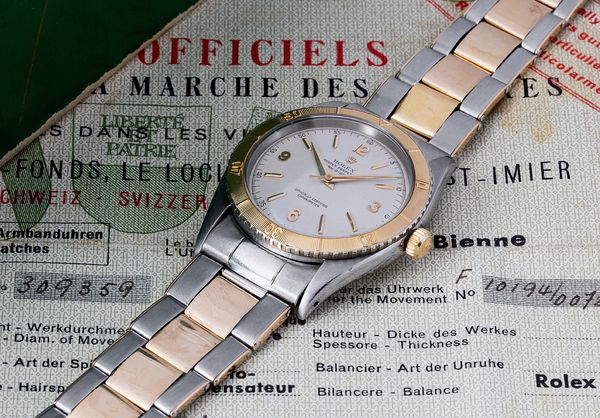The Turn-O-Graph, when originally launched by Rolex in 1953, was by all measures revolutionary in the history of watchmaking and of watch design. Its main feature, a rotatable bezel, was certainly a disruptive innovation—creating an all-new market for what was then an unheard of genre—the tool watch. With its genuinely useful function, the Turn-O-Graph was soon chosen by the Thunderbirds—the United States’ elite aerobatic squadron to aide in their pilots’ navigational calculations. Recognizing the opportunity, Rolex brilliantly propelled the success of the model by calling it the “Thunderbird” in the North American market.
The very first reference, the 6202, was the first series produced wristwatch to feature a rotating bezel. It was designed to measure and record time "as a reminder of times past, for phone calls, conferences, timing, parking, and countless other ways," as Rolex’s original advertising explained. Interestingly, the ref. 6202 was not the first Rolex model to feature such a bezel. That distinction belongs to Rolex’s Zerograph created in 1937—an elusive prototype model so rare, the fact that it exists remains a mystery until the present day.
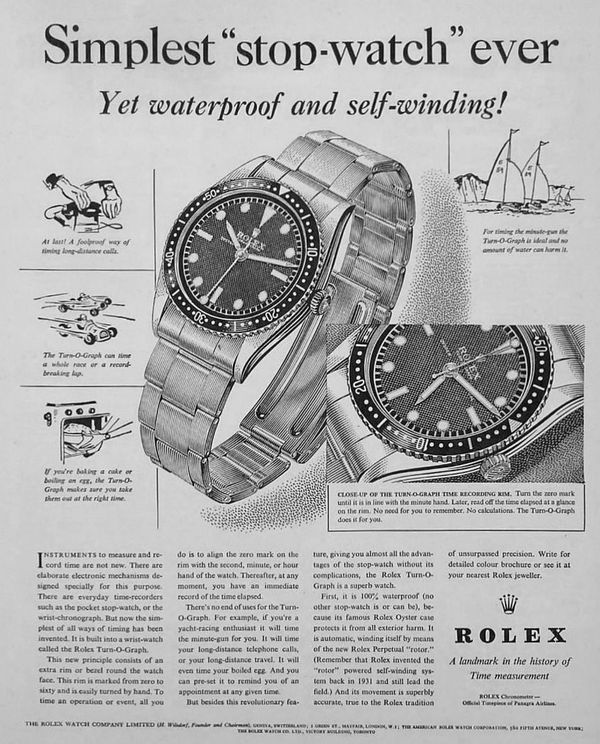
The rotating bezel of the Turn-O-Graph was a (pardon the pun) turning point for Rolex that would become the foundation for the brand’s key sports watches, including the Submariner and GMTMaster. Not only are these models amongst Rolex’s best sellers, 63 years after the Turn-O-Graph’s launch, they are considered true icons in the world of fine watches. In the formative early years of these models, it was with the Turn-O-Graph that Rolex was most experimental, even courageous.
In the following collection of lots, we present early examples of all three case metal configurations—steel, steel and gold, and an all gold Turn-O-Graph. All are impressive in their own right, with timeless designs that make them appear young as on the day they were originally sold. Each presented in superb condition, they offer tremendous value and speak volumes about the earliest history of one of the most important categories of collectible watches today—the sports watch.
Rolex "Turn-O-Graph", 6202, Stainless steel, 1953
Reference 6202 can be considered the first Rolex tool watch ever produced in series. With its rotating bezel calibrated to 60 units, the ground-breaking "Turn- O-Graph" can be considered the starting point of Rolex’s 60-plus years of successful sport watches. This example from 1953, the first year of the Turn-O-Graph’s production, is fitted with all of its original components, including its metal bezel insert.
The most striking visual element however is the glossy black dial with luminous hour markers surrounded by a gilt-colored outer chapter ring—retaining its beautiful luster and original luminous hour markers. This example is in remarkable condition for a watch of its age, with a sharp, well-defined case that is consistent with the state of preservation of the dial. Accompanied by the original Rolex guarantee, product literature, plastic wallet, and pouch, this watch is a tremendous value for the savvy collector.
Rolex Oyster Perpetual "Thunderbird", 6309, 18 yellow gold, 1954
The Rolex "Turn-O-Graph" model, has in recent times achieved cult status in the Rolex collectors community. Also known as the "Thunderbird", Rolex introduced the name for the U.S. market in the late 1950s when it began supplying the model to the U.S. Air Force’s Thunderbird aerobatic squadron. The reference 6309 was the second-generation Turn-O-Graph model introduced in 1954 with an upgraded movement and produced through 1959. Fitted with a graduated, rotating bezel, the Turn-O-Graph was designed to measure elapsed time similar to a chronograph, without the cost of a complicated chronograph caliber.
It was a revolutionary design that was quickly adopted by many brands after Rolex’s introduction. The Turn-O-Graph was essentially a Datejust model, modifed to become a tool watch by the addition of the rotating bezel. The larger bezel shrunk the visible surface area of the dial, causing the original "Swiss" of the Datejust dials used to nearly disappear. On this very early example, Rolex printed a second "Swiss Made" at 6 o’clock to ensure this important designation was clearly visible.
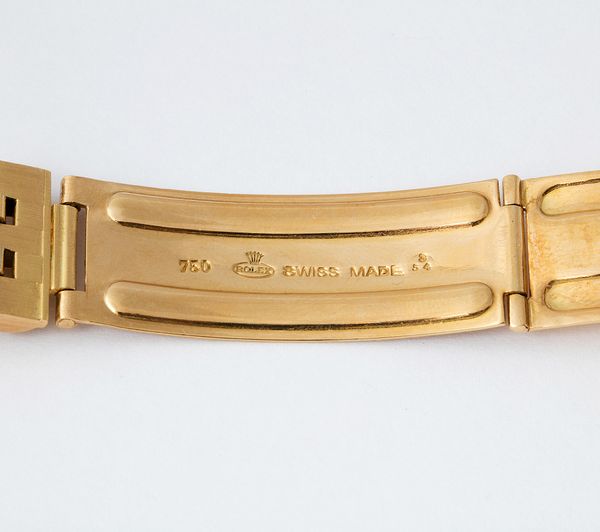
This yellow gold watch with yellow gold bracelet was at its time of production, one of the most expensive and exclusive watches produced by Rolex. The 3.54 stamped on the bracelet clasp is absolutely consistent with the case number, and when combined with its excellent condition, it is a superb example of a very early Datejust Turn-O-Graph model for the connoisseur.
In the formative early years of these models, it was with the Turn-O-Graph that Rolex was most experimental, even courageous.
Rolex Turn-O-Graph, 6202, 18k yellow gold and stainless steel, 1954
Reference 6202 can be considered the first Rolex tool watch ever produced in series. Reference 6202 also stands out as the first Rolex sports watch to be offered in stainless steel and gold—a more luxurious version compared with the sportier stainless steel model. An audacious aesthetic, particularly for the 1950s, the two-tone version was ahead of its time. It was very quickly discontinued, explaining why only a dozen of these watches are known to date. Some two decades later, Rolex would try again, launching two-tone GMT-Master and Submariner models, to a market that was finally mature enough to appreciate the look.
The two-tone reference 6202 here impresses with its amazing condition. The cream-colored dial is all original with a pleasing mix of Arabic and faceted baton hour markers complemented by its original dauphine hands. The bezel is crisp with very deep relief throughout, and the engraving "Model Depose, Registered Design" on the case back remains visible to the naked eye. Complete with its original box and chronometer certificate, it’s an exceptionally rare Rolex sports watch offering great wearability and outstanding value.
